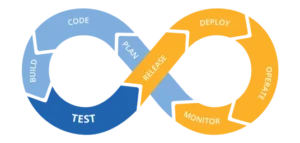Introduction
Cloud computing for beginners starts with a simple idea: storing your files securely on the internet and accessing them from anywhere, on any device. From uploading photos to Google Drive to watching Netflix, cloud computing is already part of your daily life — whether you realize it or not.
But what exactly is cloud computing? How does it work? And how can you learn it step by step?
What Is Cloud Computing?
Cloud computing for beginners is best understood as renting internet-based tools and storage instead of relying on your device.
In simple terms:
It’s like renting a powerful computer on the internet — only when you need it.
You can use cloud computing to:
-
Store files and documents
-
Run software without installing it locally
-
Host websites and applications
-
Stream videos and media
-
Build and train AI models
The best part?
No need to worry about hardware setup, electricity, or system maintenance — the cloud provider handles all of that for you.
How Does Cloud Computing Work?
One of the most important concepts in cloud computing for beginners is understanding how services like AWS, Azure, and Google Cloud deliver resources remotely. Here’s a step-by-step explanation of how cloud computing works:
-
Cloud providers like Amazon Web Services (AWS), Microsoft Azure, and Google Cloud own large data centers.
-
These data centers contain thousands of high-powered servers that store and process information.
-
You connect to these servers over the internet — like opening a website or app.
-
You use their computing power, storage, or services on demand.
-
You only pay for what you use, just like electricity or water.
Today, over 90% of companies use cloud computing in some form — it’s become essential for business and innovation.
Real-Life Examples of Cloud Computing
You’re already using cloud computing in your daily life. . Here are some common examples:
-
Google Drive: Store and share documents and photos
-
Netflix: Stream videos without downloading
-
Zoom: Join video meetings in real time
-
Canva: Design graphics directly in your browser
-
Xbox Cloud Gaming: Play console-quality games without downloading



Why Is Cloud Computing So Important?
Cloud computing is now the backbone of modern technology — from AI to remote work. Here’s why it matters:
✅ Cost-Effective
No need to invest in expensive physical servers or hardware. You pay only for the resources you use, making it ideal for both startups and enterprises.
🔄 Scalable
With cloud platforms, you can quickly increase or decrease your computing power and storage based on your needs — no need to overbuy.
🔐 Secure
Leading cloud providers like AWS, Azure, and Google Cloud offer enterprise-grade security, encryption, and compliance to protect your data.
🌐 Accessible
Work from anywhere — all you need is an internet connection. This makes cloud computing essential for hybrid work, global teams, and real-time collaboration.
🚀 Speeds Up Innovation
Cloud platforms give instant access to advanced technologies like artificial intelligence, big data analytics, and machine learning — even for beginners and small teams.
🌱 Environmentally Friendly
By sharing resources across users, cloud computing reduces overall carbon footprint. Providers often use renewable energy to power data centers.
💼 Empowers Individuals
For cloud computing beginners, it opens the door to modern tech skills, online education, portfolio-building, and even freelance or remote work opportunities.
How Can You Start Learning Cloud Computing?
Whether you’re a student, job seeker, or curious tech enthusiast, here’s how to start your cloud journey:
📘 Recommended Beginner Courses:
-
AWS Cloud Practitioner Essentials (Free on Coursera)
-
Microsoft Azure Fundamentals (Free on Microsoft Learn)
-
Udemy: Cloud Computing for Beginners (Affordable, hands-on)
💡 Bonus Tip: Start with one platform (AWS or Azure), build small projects, and gradually explore certifications.
-
🕰️ A Quick History of Cloud Computing
Cloud computing may sound like a recent invention, but its roots go back decades. Here’s a simplified timeline that shows how it evolved into the powerful tool it is today — especially useful for understanding cloud computing for beginners:
🔹 1960s – The Concept of Shared Computing
-
Visionaries like J.C.R. Licklider and John McCarthy introduced the idea of a global network where users could access programs and data from anywhere — a concept now known as utility computing.
-
This laid the foundation for modern cloud computing, though the technology wasn’t ready yet.
🔹 1999 – The First SaaS Product (Salesforce)
-
Salesforce launched the first Software as a Service (SaaS) platform.
-
For the first time, users could access enterprise-level software through a web browser — no downloads, no installation.
🔹 2006 – Birth of Public Cloud: AWS Launches
-
Amazon Web Services (AWS) introduced Elastic Compute Cloud (EC2), making it possible to rent virtual servers online.
-
This was a game-changer — businesses could now scale quickly without buying physical hardware.
🔹 2010 – Rise of Cloud Competitors
-
Microsoft Azure and Google Cloud Platform (GCP) entered the market.
-
Cloud became a multi-provider ecosystem, driving innovation and cost competition.
🔹 2014–2020 – Cloud Becomes Mainstream
-
Businesses of all sizes began shifting to the cloud.
-
Tools like Dropbox, Slack, and Zoom became cloud-first, changing how teams worked globally.
-
Developers started building apps directly in the cloud using platforms like AWS Lambda (serverless computing).
🔹 2020–2025 – Cloud Powers the Digital World
-
With the rise of remote work, online learning, and AI/ML, cloud adoption accelerated dramatically.
-
Today, cloud computing supports everything from streaming services (like Netflix) to healthcare apps, banking systems, and smart devices.
Cloud computing for beginners is no longer optional — it’s now considered a fundamental part of digital literacy.
-
Final Thoughts
Cloud computing isn’t just for tech companies — it’s becoming a basic digital skill like using email or spreadsheets. If you’re curious, now is the perfect time to start learning.
From students and freelancers to startups and enterprises, cloud computing for beginners opens up powerful tools and opportunities for everyone.
As more businesses, schools, and services move online, understanding the cloud gives you a clear edge — whether you’re preparing for a job, building a website, or simply storing your photos safely.
And the best part?
You don’t need to be a developer or IT expert to get started.
If you’re curious about how the internet really works behind the scenes, now is the perfect time to dive in. Start exploring one cloud platform, build small projects, and grow your skills from there.
✅ The future is cloud-powered — and your journey begins now.
Ready to explore more?
👉 Follow our blog [CreativeDataAI] for simple, beginner-friendly cloud tutorials and tips every week.

Nyc